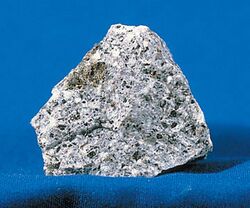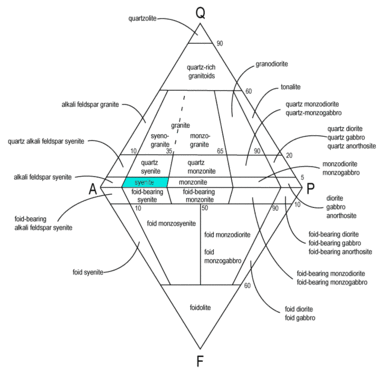Chemistry:Syenite
| Igneous rock | |
 | |
| Composition | |
|---|---|
| Plagioclase and K-Feldspars, depleted in quartz |

Syenite is a coarse-grained intrusive igneous rock with a general composition similar to that of granite, but deficient in quartz, which, if present at all, occurs in relatively small concentrations (< 5%). It is considered a granitoid. Some syenites contain larger proportions of mafic components and smaller amounts of felsic material than most granites; those are classed as being of intermediate composition.
The extrusive equivalent of syenite is trachyte.[1]
Composition
The feldspar component of syenite is predominantly alkaline in character (usually orthoclase). Plagioclase feldspars may be present in small proportions, between 10% and 35% of the feldspar content. Such feldspars often are interleaved as perthitic components of the rock.
When ferromagnesian minerals are present in syenite at all, they usually occur in the form of amphibole (typically hornblende) and clinopyroxene. Biotite is rare, because in a syenite magma the formation of feldspar consumes nearly all the aluminium. However less Al-rich phyllosilicates may be included, such as annite.
Other common accessory minerals are apatite, titanite, zircon and other opaques.
Most syenites are either peralkaline with high proportions of alkali elements relative to aluminum, or peraluminous with a higher concentration of aluminum relative to alkali (predominantly K and Na) and earth-alkali (predominantly Ca) elements.
Formation
Partial melting
Syenites are products of alkaline igneous activity, generally formed in thick continental crustal areas, or in Cordilleran subduction zones. The formation of syenites can be theorized to be from the melt of granitic or igneous protolith to a fairly low degree of partial melting. This is required because potassium is an incompatible element and tends to enter a melt first, whereas higher degrees of partial melting will liberate more calcium and sodium, which produce plagioclase, and hence a granite, adamellite or tonalite.
At very low degrees of partial melting a silica undersaturated melt is produced, forming a nepheline syenite, where orthoclase is replaced by a feldspathoid such as leucite, nepheline or analcime.
Conversely in certain conditions, large volumes of anorthite crystals may precipitate from thoroughly molten magma in a cumulate process as it cools. This leaves a drastically reduced concentration of silica in the remainder of the melt. The segregation of the silica from the melt leaves it in a state that may favour syenite formation.[citation needed]
Fractional crystallization
Some syenites are also theorized to be the product of the fractional crystallization of basaltic magmas.[2]
Occurrence
Syenite is not a common rock. Regions where it occurs in significant quantities include the following.
- In the Kola Peninsula of Russia two giant nepheline syenite bodies exists making up the Lovozero Massif and the Khibiny Mountains. These syenites are part of the Kola Alkaline Province.[3]
- In North America syenite occurs in Arkansas and Montana. Regions in New England have sizable amounts, and in New York syenite gneisses occur.[citation needed] The "great syenite dyke" extends from Hanging Rock, South Carolina, through Taxahaw, South Carolina, to the Brewer and Edgeworth mine in Chesterfield, South Carolina.[4] Syenite pebbles, containing fluorescent sodalite, were moved from Canada to Michigan by glaciers;[5] these glacial erratic pebbles have been given the trade name "yooperlite".[6] In other parts of the world, these types of rocks are known as sodalite-syenite and occur in Canada, India, other US states, Greenland, Malawi, and Russia.[citation needed]
- In Europe syenite may be found in parts of Switzerland , Germany , Norway , Portugal, Sweden, Scotland,[7] in Plovdiv, Bulgaria and in Ditrău, Romania.
- In Africa there are syenite formations in Aswan, Egypt, and in Malawi in the Mulanje Mountain Forest Reserve. Syenite rock was used to make the Quay with Sphinxes.
- In Australia syenite occurs as small intrusive bodies in nearly every state. In New South Wales, a large syenite intruded during the breakup of Gondwana in the Cretaceous.
- Paatusoq and Kangerluluk fjords in southeastern Greenland, where a bay within the latter (Syenitbugt) and a headland (Syenitnæs) are named after the rock.[8]
Etymology
The term syenite was originally applied to hornblende granite like that of Syene (now Aswan) in Egypt, from which the name is derived.
Episyenite
Episyenite (or epi-syenite) is a term used in petrology to describe veins, pods, or lenses of rock originally rich in silicon dioxide (SiO2) from which quartz has been severely depleted.[9] This is often accompanied by strong enrichment in potassium and rare earth elements, leaving the altered rock a distinctive brick red color,[10] or by albitization (enrichment in sodium), leaving the altered rock a conspicuous white color.[11]
Episyenites are heterogenous in their properties, but all have experienced nearly complete disappearance of quartz at sub-solidus temperatures; that is, at temperatures below the melting point of the host rock. The formation of episyenites (episyenitization) typically takes place through leaching of quartz by mildly saline hydrothermal fluids, typically near a cooling intrusion. Because episyenitization usually takes place in granitoid rock and usually involves alkaline metasomatism (addition of alkali metal oxides to the rock) the result is a rock that has the mineral composition of an igneous syenite.[11]
In addition to rare earth elements,[10] episyenites may be important sources of uranium[12] and other valuable metals.[11]
Notable occurrences of episyenite are found in the Central Iberian Massif of Spain,[9] in Cambrian to Ordovician beds of New Mexico and Colorado,[10] Scandinavia, Brazil, and Ukraine.[11]
See also
References
- E. Wm. Heinrich. Microscopic Petrography, McGraw-Hill, 1956
- ↑ Carracedo, J. C. (2016). The geology of the Canary Islands. V. R. Troll. Amsterdam, Netherlands. ISBN 978-0-12-809664-2. OCLC 951031503. https://www.worldcat.org/oclc/951031503.
- ↑ "ALEX STREKEISEN-Syenite-". http://www.alexstrekeisen.it/english/pluto/syenite.php.
- ↑ Downes, Hilary; Balaganskaya, Elena; Beard, Andrew; Liferovich, Ruslan; Demaiffe, Daniel (2005). "Petrogenetic processes in the ultramafic, alkaline and carbonatitic magmatism in the Kola Alkaline Province: a review". Lithos 85 (1–4): 48–75. doi:10.1016/j.lithos.2005.03.020. Bibcode: 2005Litho..85...48D. http://eprints.bbk.ac.uk/157/1/Downes4_Figs2-12.pdf.
- ↑ Lieber, Oscar Montgomery (1856). Report on the Survey of South Carolina. South Carolina General Assembly. p. 32. ISBN 9785880484188. https://books.google.com/books?id=xb8SAwAAQBAJ&q=taxahaw%20sc&pg=PA32. Retrieved 2 December 2014.
- ↑ "'Yooperlite' a new rock found in the Upper Peninsula". wilx.com. September 7, 2018. http://www.wilx.com/content/news/Yooperlite-a-new-rock-found-in-the-Upper-Peninsula-492732351.html.
- ↑ "Yooperlite". Mindat.org. https://www.mindat.org/min-53133.html.
- ↑ Gillen, Con (2013). Geology and landscapes of Scotland (2nd ed.). Dunedin. p. 188. ISBN 9781780460093.
- ↑ "Syenitnaes". Mapcarta. http://mapcarta.com/19184706.
- ↑ 9.0 9.1 Recio, C.; Fallick, A.E.; Ugidos, J.M.; Stephens, W.E. (December 1997). "Characterization of multiple fluid-granite interaction processes in the episyenites of Avila-Béjar, Central Iberian Massif, Spain". Chemical Geology 143 (3–4): 127–144. doi:10.1016/S0009-2541(97)00106-X. Bibcode: 1997ChGeo.143..127R.
- ↑ 10.0 10.1 10.2 McLemore, Virginia T. (2016). "Episyenites in the Sevilleta National Wildlife Refuge, Socorro County, New Mexico: preliminary results". New Mexico Geological Society Field Conference Series 67: 255–262. https://nmgs.nmt.edu/publications/guidebooks/downloads/67/67_p0255_p0262.pdf. Retrieved 11 June 2020.
- ↑ 11.0 11.1 11.2 11.3 Suikkanen, E.; Rämö, O. T. (October 2019). "Episyenites—Characteristics, Genetic Constraints, and Mineral Potential". Mining, Metallurgy & Exploration 36 (5): 861–878. doi:10.1007/s42461-019-00120-9.
- ↑ Leroy, J. (1 December 1978). "The Margnac and Fanay uranium deposits of the La Crouzille District (western Massif Central, France); geologic and fluid inclusion studies". Economic Geology 73 (8): 1611–1634. doi:10.2113/gsecongeo.73.8.1611. Bibcode: 1978EcGeo..73.1611L.
 |




